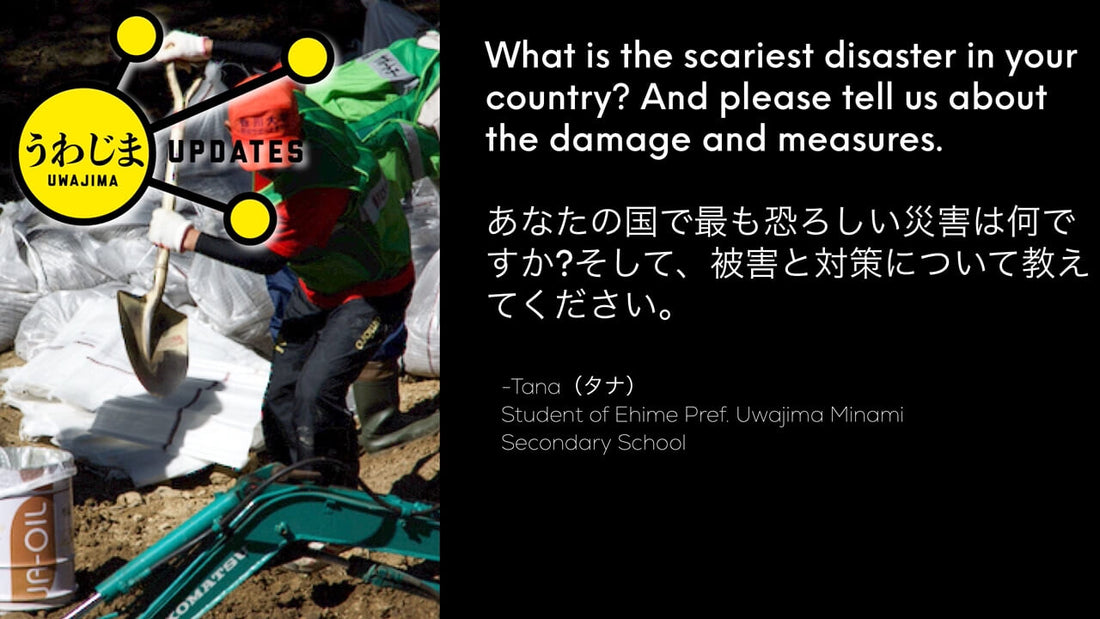
Q: What is the scariest disaster in your country? And please tell us about the damage and measures. あなたの国で最も恐ろしい災害は何ですか?そして、被害と対策について教えてください。
Masaki SeikeShare
The Question is from: Tana(タナ)
Answer from Char350 (USA):
When I lived in Los Angeles, the most common type of disasters are wildfires. Fires not only directly burns down homes and the surrounding nature, but also hurts air quality that may extend to areas as far as hundreds of kilometers. The local government keeps citizens informed over the news, internet, etc. and announces mandatory and optional evacuations to affected areas.
私がロサンゼルスに住んでいたとき、最も一般的な災害は山火事です。火災は家や周囲の自然を直接燃やすだけでなく、数百キロメートルの地域に及ぶ可能性のある空気の質も損なう。地方自治体は、ニュース、インターネットなどで市民に情報を提供し、被災地への必須およびオプションの避難を発表します。
Answer from MAJESTY UBER RED (PHILIPPINE):
For me, it has to be 2009’s Typhoon Ondoy disaster that hit Metro Manila in the Philippines with a massive flood and storm. My old house was flooded to the second floor, unlike the past storms which only flooded the first floor up to halfway, and I had no choice but to hold on to some of the stuff we had to save. In return, we had a lot of other things we couldn’t save that were all soaked in the flood water. It took several days for everyone affected by the floods to recover and get back to normal living.
私にとっては、大規模な洪水と嵐でフィリピンのマニラ首都圏を襲ったのは2009年の台風オンドイ災害でなければなりません。私の古い家は、1階を中途半端に浸水させた過去の嵐とは異なり、2階に浸水し、私たちが救わなければならなかったもののいくつかにしがみつくしかありませんでした。その見返りに、私たちは保存できない他の多くのものを持っていましたが、それはすべて洪水に浸っていました。洪水の影響を受けたすべての人が回復し、通常の生活に戻るのに数日かかりました。
Answer from ANDREW CHARLES HAGER (USA):
Besides what happened to the Twin Towers back in September 11th, 2001, the scariest disaster I ever witnessed was when a house caught fire across the street from where I lived due to arson. It happened right in the middle of the night. I didn’t know the old man who lived there, but he was asleep while the fire burned and he died. The fire fighters managed to put the fire out, but the house was completely destroyed. I never felt so scared in my entire life.
2001年9月11日にツインタワーに起こったことに加えて、私が今まで目撃した最も恐ろしい災害は、放火のために私が住んでいた通りの向かいに家が火事になったときでした。それは真夜中に起こった。私はそこに住んでいた老人を知らなかったが、火が燃えている間、彼は眠っていて死んでいた。消防士たちはなんとか火を消したが、家は完全に破壊された。私は人生でこんなに怖かったことはありません。
Answer from ZACK HULSE (USA):
At 8:32 a.m. PDT on May 18, 1980, Mount St. Helens, a volcanic peak in southwestern Washington, suffers a massive eruption, killing 57 people and devastating some 210 square miles of wilderness.
Called Louwala-Clough, or “the Smoking Mountain,” by Native Americans, Mount St. Helens is located in the Cascade Range and stood 9,680 feet before its eruption. The volcano has erupted periodically during the last 4,500 years, and the last active period was between 1831 and 1857. On March 20, 1980, noticeable volcanic activity began with a series of earth tremors centered on the ground just beneath the north flank of the mountain. These earthquakes escalated, and on March 27 a minor eruption occurred, and Mount St. Helens began emitting steam and ash through its crater and vents.
Small eruptions continued daily, and in April people familiar with the mountain noticed changes to the structure of its north face. A scientific study confirmed that a bulge more than a mile in diameter was moving upward and outward over the high north slope by as much as six feet per day. The bulge was caused by an intrusion of magma below the surface, and authorities began evacuating hundreds of people from the sparsely settled area near the mountain. A few people refused to leave.
On the morning of May 18, Mount St. Helens was shaken by an earthquake of about 5.0 magnitude, and the entire north side of the summit began to slide down the mountain. The giant landslide of rock and ice, one of the largest recorded in history, was followed and overtaken by an enormous explosion of steam and volcanic gases, which surged northward along the ground at high speed. The lateral blast stripped trees from most hill slopes within six miles of the volcano and leveled nearly all vegetation as far as 12 miles away. Approximately 10 million trees were felled by the blast.
The landslide debris, liquefied by the violent explosion, surged down the mountain at speeds in excess of 100 miles per hour. The avalanche flooded Spirit Lake and roared down the valley of the Toutle River for a distance of 13 miles, burying the river to an average depth of 150 feet. Mudflows, pyroclastic flows, and floods added to the destruction, destroying roads, bridges, parks, and thousands more acres of forest. Simultaneous with the avalanche, a vertical eruption of gas and ash formed a mushrooming column over the volcano more than 12 miles high. Ash from the eruption fell on Northwest cities and towns like snow and drifted around the globe for two weeks. Fifty-seven people, thousands of animals, and millions of fish were killed by the eruption of Mount St. Helens.
By late in the afternoon of May 18, the eruption subsided, and by early the next day it had essentially ceased. Mount St. Helens’ volcanic cone was completely blasted away and replaced by a horseshoe-shaped crater–the mountain lost 1,700 feet from the eruption. The volcano produced five smaller explosive eruptions during the summer and fall of 1980 and remains active today. In 1982, Congress made Mount St. Helens a protected research area.
Mount St. Helens became active again in 2004. On March 8, 2005, a 36,000-foot plume of steam and ash was expelled from the mountain, accompanied by a minor earthquake. Another minor eruption took place in 2008. Though a new dome has been growing steadily near the top of the peak and small earthquakes are frequent, scientists do not expect a repeat of the 1980 catastrophe anytime soon.
Even though I was born 5 years after this event This was the worse disaster in my area that I am aware of.午前8時32分1980年5月18日(太平洋夏時間)、マウントストリートワシントン南西部の火山ピークであるヘレンズは、大規模な噴火に苦しみ、57人が死亡し、約210平方マイルの荒野を壊滅させた。
ネイティブアメリカンのMount StによってLouwala-Clough、または「喫煙山」と呼ばれています。ヘレンズはカスケード山脈に位置し、噴火の9,680フィート前に立っていた。火山は過去4,500年間に定期的に噴火し、最後の活動期間は1831年から1857年の間でした。1980年3月20日、顕著な火山活動は、山の北側面のすぐ下の地面を中心とした一連の地球の揺れから始まりました。これらの地震はエスカレートし、3月27日に軽微な噴火が発生し、マウントセントヘレンズはクレーターと通気口から蒸気と灰を放出し始めた。
小さな噴火は毎日続き、4月に山に精通した人々は北面の構造の変化に気づいた。科学的研究では、直径1マイル以上の膨らみが1日あたり6フィートも高い北斜面の上方と外側に移動していることが確認された。膨らみは表面下のマグマの侵入によって引き起こされ、当局は山の近くのまばらに定住した地域から何百人もの人々を避難させ始めました。何人かの人々は去ることを拒否した。
5月18日の朝、マウントストリート。ヘレンは約5.0マグニチュードの地震で揺れ、山頂の北側全体が山を滑り降り始めた。史上最大の記録の1つである岩氷の巨大な地すべりは、蒸気と火山ガスの巨大な爆発に追い越され、高速で地面に沿って北上しました。横方向の爆発は、火山から6マイル以内のほとんどの丘の斜面から木を取り除き、12マイル離れたほぼすべての植生を平らにしました。爆発で約1000万本の木が伐採された。
激しい爆発によって液化した地すべりの破片は、時速100マイルを超える速度で山を駆け下りた。雪崩はスピリットレイクに浸水し、タウトル川の谷を13マイルの距離で轟音を立て、川を平均深さ150フィートに埋めた。泥流、火砕流、洪水が破壊に追加され、道路、橋、公園、さらに数千エーカーの森林を破壊します。雪崩と同時に、ガスと灰の垂直噴火は、高さ12マイル以上の火山の上にキノコ柱を形成しました。噴火による灰は、雪のような北西部の都市や町に落ち、2週間世界中を漂流した。セント山の噴火で57人、何千もの動物、そして何百万もの魚が殺されました。ヘレンズ。
5月18日の午後遅くまでに噴火は収まり、翌日の初めまでに本質的に停止していた。マウントセントヘレンズの火山コーンは完全に吹き飛ばされ、馬蹄形のクレーターに置き換えられました。山は噴火から1,700フィートを失いました。火山は1980年の夏と秋に5つの小さな爆発性噴火を生み出し、今日も活動しています。1982年、議会はマウントセントを作った。ヘレンズは保護された研究地域です。
マウントセントヘレンズは2004年に再び活動した。2005年3月8日、小地震を伴って36,000フィートの蒸気と灰が山から排出された。2008年に別の軽度の噴火が起こった。新しいドームはピークの頂上付近で着実に成長しており、小さな地震が頻繁に発生していますが、科学者たちはすぐに1980年の大惨事の繰り返しを期待していません。
私はこのイベントから5年後に生まれましたが、これは私が知っている私の地域で最悪の災害でした。
Answer from MICHAEL (Australia) :
Every summer in Australia, it is the constant threat of bushfire. To give you an idea February 7, 2009, the Australian state of Victoria experienced as many as 400 individual bushfires. While the exact amount of land these wildfires scorched is disuputed, it is agreed the area burned was greater than 4,500 square kilometers (1,737 square miles). The fires also destroyed 2,029 homes, and killed 173 people. This was a scary time as at the same time where I live in South Australia we also had multiple bushfires in 2020 on Kangaroo Island Of the 440,500 hectare island, approximately 211,000 hectares has been affected by this fire. This affected not only the residents but the animals on island, over a third of the island is protected in nature reserves, home to native wildlife like sea lions, koalas and diverse bird species.
オーストラリアでは毎年夏には、山火事の絶え間ない脅威です。2009年2月7日のアイデアを与えるために、オーストラリアのビクトリア州は400もの個々の山火事を経験しました。これらの山火事が焦げた土地の正確な量は混乱しているが、焼かれた面積は4,500平方キロメートル(1,737平方マイル)を超えていたと合意されている。火災はまた2,029軒の家を破壊し、173人が死亡した。私が南オーストラリア州に住んでいると同時に、2020年にカンガルー島で440,500ヘクタールの島で複数の山火事があり、約211,000ヘクタールがこの火災の影響を受けているので、これは恐ろしい時期でした。これは住民だけでなく島の動物だけでなく、島の3分の1以上が自然保護区で保護されており、アシカ、コアラ、多様な鳥類などの在来の野生生物が生息しています。
This page is solely created for "Uwajima World Link," Office Seike's weekly FM radio program on Wednesdays, 1:00 PM- 1:55 PM JST, broadcasting from Uwajima City, located in the southern part of Ehime Prefecture, Japan.
The questions we present here are from students from Ehime Pref. Uwajima Minami Secondary School in Uwajima City. They are eager to learn English & various cultures out there in the world.
We, Office Seike, strongly believe learning other languages and cultures brings broader perspectives and hints to local cities like our hometown Uwajima. Also, it helps us discover and appreciate our unique traditions and rich local cultures. We sincerely hope your answers to these students' questions inspire them, guide them, and let them be interested in you and your cultures.
Please leave us your comments and answers from below.
このページは、愛媛県南部に位置する宇和島市から放送される、オフィス・セイケの週刊FMラジオ番組「宇和島ワールドリンク」用に作成されています。
ここで紹介する質問は、愛媛県立宇和島南中等教育学校の学生さんからのものです。彼らは世界中の英語と様々な文化を学ぶことを熱望しています。
私たちオフィス・セイケは、他の言語や文化を学ぶことは、故郷の宇和島のような地方都市により広い視点や発展のヒントをもたらすと強く信じています。また、私たちのユニークな伝統と豊かな地元の文化を自身が発見し、大切にすることに役立ちます。これらの学生の質問に対するあなたの答えが、彼らを鼓舞し、導き、彼らがあなたの文化にも興味を持ってもらうことを心から願っています。
以下からご意見や回答をお寄せください。
よろしくお願いします。
Thank you in advance.
Masaki Seike, Director.
